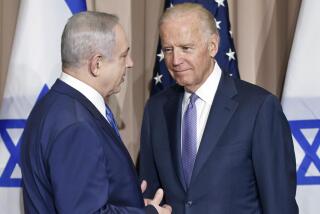U.S.-Japan Jet Venture a True Test of Trust
Shoe on the other foot--and causing discomfort. Japan’s Mitsubishi Heavy Industries will develop a fighter plane in cooperation with General Dynamics, and the prospect has aroused controversy in Washington.
The new plane, called the FSX, will be a derivative of General Dynamics’ F-16. It is not the first fighter plane Japan has worked on. Dating to the 1950s, Mitsubishi Heavy Industries (MHI) has built F-15, F-104 and F-86 fighters under license and has been a subcontractor for the Boeing 767 and other commercial planes.
But this time it’s different. MHI’s $2-billion (revenue) aircraft division will be the prime contractor--responsible for designing and integrating all the elements of a modern, technically complex fighter plane--and General Dynamics, the $9.3-billion St. Louis-based defense firm, will be the subcontractor, working to MHI’s specifications.
The program has been controversial ever since the Japanese government declared in 1986 that its companies would go it alone in building a new fighter for the self-defense forces of Japan--a nation pledged by its constitution not to maintain large military forces.
Would Go Alone
The U.S. government, which wanted Japan to buy an American plane and help correct the trade imbalance, objected to the go-it-alone idea. So the two governments negotiated the present venture, in which whatever new technology Japan develops from its exposure to the F-16 will be shared with General Dynamics and 35% to 40% of the work will be done in the United States, probably at the General Dynamics plant in Ft. Worth.
Supporters of the arrangement--including the departments of Defense and State--say it’s the best deal the United States could get, that Japan will proceed on its own if the United States now backs out.
Opponents accuse the Japanese government of duplicity and angrily question its declarations of wanting to buy American products. “If they want to buy American,” says one Senate staffer, “surely no one in the world makes better fighter planes.”
Behind the anger, there’s anxiety--fear that Japanese companies will use technology acquired in the FSX venture to expand in the commercial or military aerospace industry--”the only high-technology area in which the United States remains the undisputed world leader,” said 12 U.S. senators in a letter last week to President Bush. The senators urged that the FSX deal be strongly reviewed--and questions will certainly be asked this Friday when the Senate Foreign Relations Committee is asked to approve an export license for the venture.
Those questions will go to the heart of the “special relationship” the United States and Japan say they want. Indeed, the FSX deal could prove a milestone in that special relationship or a boulder in the road.
Useful for Future
The real story behind FSX is that Japan wants skills and status. MHI has done licensed production, explains Takaaki Yamada, general manager of aircraft for the company. “But that means design has been conducted by the U.S. side. With the new ventures, we can learn designing and procurement and other elements necessary to manufacture on a truly large scale.”
But that’s talking about cooperation, not competition, adds Yamada during an interview in his Tokyo office. “We are not talking about sending small planes to America the way Japanese industry sent small cars,” he says. Instead, the skills MHI picks up will be “very useful for future Japan-U.S. joint development of aircraft and for civil aircraft ventures, too.”
The skills Yamada is talking about go beyond gadgetry. To design and build today’s heavily electronic military aircraft requires abilities in systems integration--one of those vague-sounding information skills that nonetheless is all important if one is sending a missile to its target or a mission to the moon.
It’s the kind of skill that is key to the vaulting ambitions of Japan and its industrial complex today. According to MHI, which will launch its H-2 space rocket in 1992, those ambitions include a Japanese “space shuttle in 1995 and an orbiting space station in 1998.”
But let’s come down to earth. The Japanese are not that good. In aircraft and systems work, they reportedly take twice as long to produce an F-15 as McDonnell Douglas’ domestic plants, and deliveries to Boeing are said to be slow. If the Japanese were to go it alone on a new fighter, it could take them extra years and cost additional billions. So they want a helping hand from U.S. defense technology, as in the past Japanese companies have benefited from U.S. industrial technology.
Should they get it, as supporters of FSX suggest, or be denied it as Senate critics of the proposed venture believe? The answer, on balance, is that FSX should go forward.
The question is really one of trust, not trade or technology. The record, unfortunately, may not be reassuring. In the industrial world, Japan has used joint ventures merely for competitive advantage and taught U.S. companies to always cut the cards.
Nonetheless, the U.S. military already includes Japanese companies in strategic planning; Mitsubishi Heavy Industries and other companies have been asked to participate in the Pacific Region portion of the Strategic Defense Initiative. So approval of FSX makes sense.
If the United States is to count Japan as a partner in defense, then it has to accept it as a more than a junior partner. The risk in FSX is that years from now the United States could find it has created a competitor in aerospace, just as in other industries.
But it’s a risk worth taking if it leads to future joint development of aircraft and weapons, as Mitsubishi says. And it’s a risk that must be taken if the words “special relationship” are to become anything more than talk.
More to Read
Inside the business of entertainment
The Wide Shot brings you news, analysis and insights on everything from streaming wars to production — and what it all means for the future.
You may occasionally receive promotional content from the Los Angeles Times.










